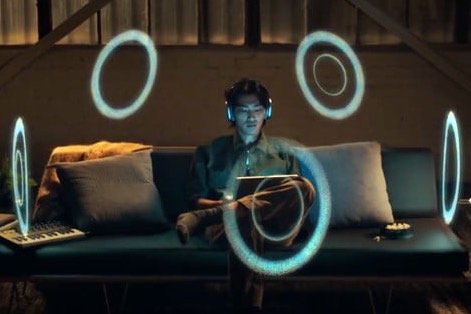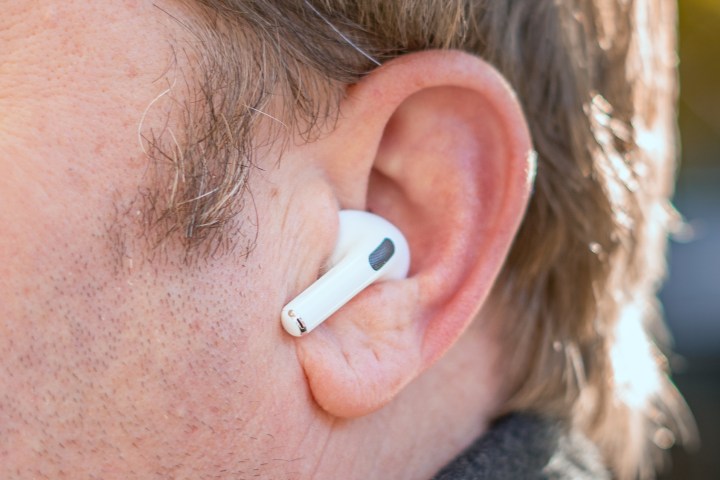Last week, as part of its WWDC 2021 announcements, Apple revealed that it had enabled Dolby Atmos Music for thousands of tracks on Apple Music. The best part? The new immersive music format will work when using any set of wired or wireless headphones as long as you’re using an Apple device (like an iPhone or iPad) for playback.
But the same isn’t true for listening to Dolby Atmos movie soundtracks using headphones. For video content with Dolby Atmos audio, you must use either the AirPods Pro or the AirPods Max. Why did Apple place this restriction on Atmos for movies but not for music? Here’s what you need to know.
You’re the center of the universe

Spatial audio — an umbrella term for 3D sound that includes surround sound formats like Dolby Atmos and DTS:X — is all about delivering an immersive sound experience that goes beyond traditional two-channel stereo. But how spatial audio accomplishes this can vary a lot. The kind of content you’re listening to and the equipment you use to hear it all play a role in how spatial audio works.
The intent, however, is always the same: To place the listener (and/or viewer) within the sound field so that they experience a greater sense of depth, width, height, and can perceive movement as individual sounds change their positions throughout playback.
Spatial for music

Music performances can benefit from spatial audio in two ways. First, musicians and their producers can exert a ton of control over where each instrument and vocal element “appears” relative to the listener. Instead of the usual left-right placement offered by stereo, the drum kit can sit behind the listener, and backing vocals can be made to sound as though they’re being sung from an overhead position.
These elements don’t need to be static. If the musician wants, they can move these sound “objects” independently from one another, and there’s almost no limit to the number of sounds they can control this way.
This version of spatial audio is technology as a creative tool, giving artists an entirely new canvas on which they can paint their music.
Second, spatial audio can be used to reproduce a very specific type of music experience, like attending a live concert. Sony’s 360 Reality Audio (360RA) is a great example of this kind of spatial audio, as it seeks to place the listener in a studio or in front of a stage, with the musicians arranged in specific locations but generally not moving about.
For the most part, (we’ll discuss an exception below) it doesn’t matter how you, as the listener, are oriented. You can turn your head in any direction or even be lying on your back — spatial audio for music experienced through headphones should sound the same regardless.
Spatial for movies

When it comes to movies, spatial audio tries to make the experience of watching films more realistic and engaging by turning the soundtrack into an extension of the on-screen action. When a helicopter flies overhead from the camera’s point of view (and thus our point of view), a Dolby Atmos soundtrack moves just the wump-wump sound of the chopper’s blades from the speakers at the front of the room to the ones overhead, leaving the music part of the soundtrack alone.
This is important: Music presented in Dolby Atmos doesn’t usually attempt to connect your sound experience to visual content. But Atmos for movies or videos (or video games) is designed around the concept of the screen as the “front.”
When sitting in a theater (or at home), turning your head doesn’t change where the sounds are coming from because the position of the theater speakers is fixed.
This relationship of the screen to the viewer is easy to maintain when neither the screen nor the speakers move around. It’s even possible to keep the effect when using the built-in speakers on a phone, tablet, or laptop. But when you introduce headphones, it’s a different story.
Tracking your head

In order to preserve the multichannel, multi-speaker sound of Dolby Atmos for movies when you put on your headphones, two things need to happen.
All of the sound that would normally be coming from speakers placed around your room needs to be virtualized into a two-channel presentation. This is the technology that tricks your brain into thinking that a sound is coming from behind your head, even though it’s actually coming from those tiny speakers you’re wearing.
If we stopped there, you’d still get the full benefit of spatial audio — that sense of depth, width, and height, with sounds all moving independently through that 3D space. But, if during that helicopter scene, you were to turn your head to the right, the helicopter sound would appear to suddenly move from the screen to the right side of the room. That’s because, under normal circumstances, the movie you’re watching has no idea that you’ve looked away from the screen.
So to achieve an immersive — and dynamic — sound experience (one that can adjust on the fly to changes in the orientation of the listener’s head) we need a second technology: Head tracking.
With head tracking, the virtualized Dolby Atmos soundtrack can stay locked to the position of the screen you’re watching, even as you move your head. This keeps the helicopter sound traveling in the right direction, regardless of which way your head happens to be turned.
At the moment, only the Apple AirPods Pro and AirPods Max include the sensors needed for Apple to perform this head-tracking function.
What if I don’t care about head tracking?
Good question. As much as head tracking is clearly helpful for preserving the spatial audio experience while wearing headphones, it’s not mandatory. Anyone who keeps their head oriented toward the screen should be able to get full and accurate spatial audio immersion.
But at the moment, Apple has set a higher standard for video-based spatial audio via headphones and only enables Dolby Atmos for video if you own one of its two compatible AirPods models.
Apple hasn’t indicated when or if it will revisit this policy, which means that it will likely fall to services like Netflix, Disney+, Amazon Prime Video, and any other streaming service that supports Dolby Atmos, to enable the feature for headphone users — on Android devices.
Why doesn’t spatial audio for music use head tracking?
Right now, Apple doesn’t use the AirPods Pro and Max’s head-tracking tech for Dolby Atmos Music tracks on Apple Music, but it has said the feature is coming.
For a lot of songs, adding head tracking won’t really improve the experience. Much like stereo before it, you can be hanging upside down with your eyes closed and still enjoy the extra dimensions that spatial audio brings to music.
But some tracks will definitely be enhanced by head tracking. Any songs that were recorded at a live performance (as opposed to in-studio) will feel far more real when the band’s presence on stage is locked into place relative to your head’s orientation.
For live music fans, this will be a big reason to adopt Apple Music on an Apple device, along with the AirPods Pro and AirPods Max.



